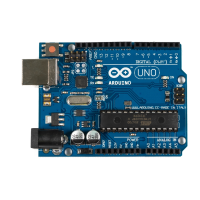CHAPTER 8
Generating Video Signals with an Arduino
So far we’ve used several different technologies to communicate with the
outside world. We’ve used LEDs to represent our binary die’s results, for
example, and we’ve used the serial port to send more elaborate messages.
We’ve also turned data received on the serial port into shiny applications
running in our browser.
For many projects this way of displaying information is sufficient, but in some
cases you want a real display. You could use an LCD display, for example,
and you’ll find multicolor TFT touch displays you can attach to the Arduino,
too. Another option is surprisingly cheap: you can connect the Arduino to
your TV set and display information right on the screen.
In this chapter, not only will you learn how analog TV works in principle,
you’ll also learn how to generate a stable monochrome video signal using your
Arduino. At the end of the chapter, you’ll have a graphical thermometer that
will run on the TV set in your living room.
report erratum • discuss
www.it-ebooks.info

